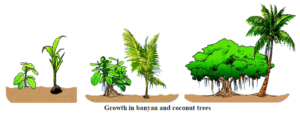The Living World
Maharashtra Board Class 6th General Science Chapter 2
Notes
|
Topics to be learn :
|
Characteristics of living things :
Growth, Necessity of food, Respiration, Excretion, Reproduction, Responsiveness to stimuli, Movement, Definite lifespan, Cellular structure are the characteristics of living things.
The above features are explained below :
Growth : The intake of food and the resultant growth is an important characteristic of living things.
- The growth of living things is from within the body and in all parts of the body.
- Living things can grow and get to their adult size in certain fixed period.
- Human babies require 18 to 21 years for complete physical growth. During this period they gain height, weight and strength.

Differences between the young ones and the adults :
| Young | Adults |
| Young ones are smaller in size, height and weight. | Adult animals are strong and bigger in size, height and weight. |
| Dependent on their mother. | Adult can stay independently, feeds by itself. |
| Young ones are immature and they keep on playing. | Adult becomes serious and searches for food and other things. |
Growth of plants : Though all living things grow, animals grow only for a certain period. Plants, on the other hand, grow as long as they live.
- When plants grow there is increase in the width and height of the stem.
- Some plants develop branches while others lack these.

Food is necessary for growth :
Plants prepare their own food with the help of sunlight and chlorophyll. Hence they are called autotrophs.
- Plants make their own food in sunlight.
- Plants produce food from water, nutrients in the soil and the carbon dioxide present in the air. During this process, plants give out oxygen.
- This process takes place in the leaves of plants, with the help of the chlorophyll in the leaves.
- This process of food production is called photosynthesis.
- Plants appear mainly green in colour due to the chlorophyll in them.
Animals cannot prepare their own food. They obtain food from plants or other animals. Hence they are called heterotrophs.
There are three types of animals based on eating habits.
- Herbivores: Primarily consume plants. Examples : Cows, deer, and elephants1.
- Carnivores: Primarily consume other animals. Examples : Lions, tigers, and wolves.
- Omnivorous animalsare those that eat both plants and animals. Example, Humans.
Respiration :
- All living things need oxygen for their survival.
- Inhaling the oxygen and exhaling the carbon dioxide is called respiration.
- In animals there are specialized respiratory organs while plants respire through the microscopic pores on their stems and leaves.
- Animals such as fish, snake, mouse, etc. have specific organs for respiration.
Excretion :
- Excreta : The waste substances formed during the different processes that take place in the bodies of the animals is called excreta.
- Excretion : The process of elimination of waste products from the body is called excretion.
- Excretory organs : Specialized organs present in the animals for the excretion are called excretory organs.
- In plants, the waste substances are stored in the leaves and then shed along with leaves or sometimes through the barks of the trees. Plants also secrete excess of water in the form of water vapours.
Responsiveness to stimuli and movement :
- All the living things respond to the activity that occurs in their near surroundings.
- This ability to respond to a stimulus is called responsiveness.
- Living things move of their own accord. Animals can change their place at the time of movement but plants cannot. However, they also show movements in the form of responsiveness to various stimuli.
Reproduction :
- In the process of reproduction, the living thing gives rise to young one of its own kind.
- Some animals give birth to their young ones. Some lay the eggs from which the young ones hatch out.
- Plants reproduce through seeds, parts of the stem, leaves, etc.
A definite lifespan :
- Every living thing has a fixed lifespan. Life comes to an end with death when organs become weak.
- Every plant and animal has different lifespan. e.g. Dog : 12 to 18 years, Ostrich : 50 years, Giant turtle on the Galapagos island : 170 years.
A cellular structure :
All the living things are made up of cells.
- Unicellular organisms : The living things made of a single cell are called unicellular organisms. e.g. Amoeba, Paramoecium, Bacteria, etc.
- Multicellular organisms : These organisms are made of many cells. e.g. man, cockroach, mouse, banyan tree, etc. Number of cells vary in different organisms.
All the living things show cellular structure.
Useful and Harmful living things :
Many animals and plants are useful to us in our daily life. Some animals and plants can be harmful to us.
(a) Plants :
Useful plants :
- The food which we consume daily is obtained from plants. Rice, dal, chapattis, bread, fruits and vegetables all are obtained from plants.
- Fruits, vegetables, grains, green leafy vegetables, etc. are obtained from different types of plants.
- Some plants are used as medicines. e.g. Vasaka (Adulsa), hirda, behada, Asparagus (Shatavari), etc.
- Agriculture and horticulture are entirely dependent on plants.
Harmful plants :
- Pods of nettle, colocassia leaves cause itching.
- Plants like oleander and lantana have very strong repelling odour.
- The Datura plant is poisonous.
- Some weeds destroy farmlands.
- Some algae show uncontrolled growth in the water bodies and may destroy it completely.
(b) Animals :
Useful animals :
- Some animals are domesticated. e.g. cow, buffalo.
- Some are used as pets, e.g. dogs, cats.
- Animals such as camel, horse, oxen, etc. are used as means of transport.
- Fish, sheep and goats, fowls are used as food. These animals are useful in occupations.
- Earthworm is useful for agriculture.
Harmful animals :
- Mosquitoes, flies, fleas, lice and similar such insects spread the diseases.
- Some insects spread skin infections.
- Rats and mice destroy our food.
- Poisonous animals like snakes and scorpions can kill a person.
- Wild animals like leopards can kill our pets, domestic animals or even human beings if they enter the human settlements.
- Elephants and monkeys from nearby forested areas can cause damage to crops and fruit trees.
Wild animals :
- Wild animals that hunt other animals for feeding are called predators. e.g. tigers, lions, leopards, wolves, etc.
- Due to deforestation and encroachment of man into forest, there is animal-human conflict.
Remember : Many plants and animals in nature satisfy our needs. We should protect and conserve these.
| Know This :
Institutes at work : The institutes that work for the survey and conservation of the various plants and animals in different parts of India are, · Botanical Survey of India (1890) (for plants) · Zoological Survey of India (1916) (for animals) National Geographic and Discovery are the television channels that give detailed information about the animals and plants. |
Useful links of Class 6th General Science :
| Main Page : Class 6th MSBSHSE – General Science - All chapters notes, solutions, videos, test, pdf.
Books : Maharashtra Board-Class 6th Science Text Books – Chapter wise PDF for download Previous Chapter : Chapter 1 : Natural Resources – Air, Water and Land - Online Notes Next Chapter : Chapter-3-Diversity in Living Things and their Classification- Online Notes |
yes
good work